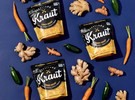While the condiment category has long offered jars of pickled sauerkraut a home, at least one manufacturer is counting on a newer approach to the product.
Launching in 2014 (though 2015 into retail), Cleveland Kraut based in Cleveland, Ohio introduced its concept of fresher, unique sauerkrauts. Today, its line includes krauts such as Gnar Gnar (similar to Kimchi), Cabbages and Cukes kraut, Beet Red kraut, Curry kraut and more.
With the product made in Cleveland, most of its raw materials are sourced from the Midwest as well. “We source directly from a cooperative of farmers who have farms in Ohio and Michigan. The end of September is the last harvest from the Midwest,” says Cleveland’s Mac Anderson. “Towards the colder months, they have farms farther south in Georgia and Florida.” The cooperative also cleans and cores the cabbage in the field which Anderson says makes for fresher product for their thicker-cut krauts.
Moving out of meat  Cleveland also capitalizes on the freshness of the product by preferring to position itself in the produce aisle. “Produce is the ideal place for us. We take fresh vegetables, ferment them for 30 days and then giving them back to the department with a whole year shelf life,” says Anderson. “Some of our consumers, such as vegans, aren’t venturing over to the meat department where sauerkraut is sometimes held. That’s why we’re pushing hard to be merchandised in produce.”
Cleveland also capitalizes on the freshness of the product by preferring to position itself in the produce aisle. “Produce is the ideal place for us. We take fresh vegetables, ferment them for 30 days and then giving them back to the department with a whole year shelf life,” says Anderson. “Some of our consumers, such as vegans, aren’t venturing over to the meat department where sauerkraut is sometimes held. That’s why we’re pushing hard to be merchandised in produce.”
The company also pushed for a more recent change to package its product in vented stand-up pouches rather than glass jars. “Due to the probiotic and fermented nature of the product, jars were challenging,” he says, noting that bulging and bubbling were an issue for consumers. “Now with the shift in July to stand-up pouches, not only was it easier to automate our process but it also allows fermentation to continue.”
Eyeing growth  While the company continues to grow in supply—it’s currently in 32 states with heavier presence in the Midwest and the northeast and will expand its supply in the southwest in the next six months—Anderson knows that while Cleveland’s krauts appeal to newer sauerkraut eaters, it can also catch the eye of more traditional kraut consumers.
While the company continues to grow in supply—it’s currently in 32 states with heavier presence in the Midwest and the northeast and will expand its supply in the southwest in the next six months—Anderson knows that while Cleveland’s krauts appeal to newer sauerkraut eaters, it can also catch the eye of more traditional kraut consumers.
“It’s a segmented market because there’s a large supply of the older school, pasteurized that people were used to. Then there’s companies like ours doing raw, fermented, fresh sauerkraut,” he says. “We’re also driving new consumption occasions so sauerkraut isn’t just for brats and perogies anymore. We’re seeing it salad bars, on fish tacos, in tofu wraps, fresh salads and more.” That said, Anderson notes that Cleveland’s Classic Caraway brand is its leading flavour and that it’s one flavour traditional eaters are most likely to try.
For more information:
Mac Anderson
Cleveland Kraut
Tel: +1 (216) 264-6895
[email protected]
https://www.clevelandkraut.com/
